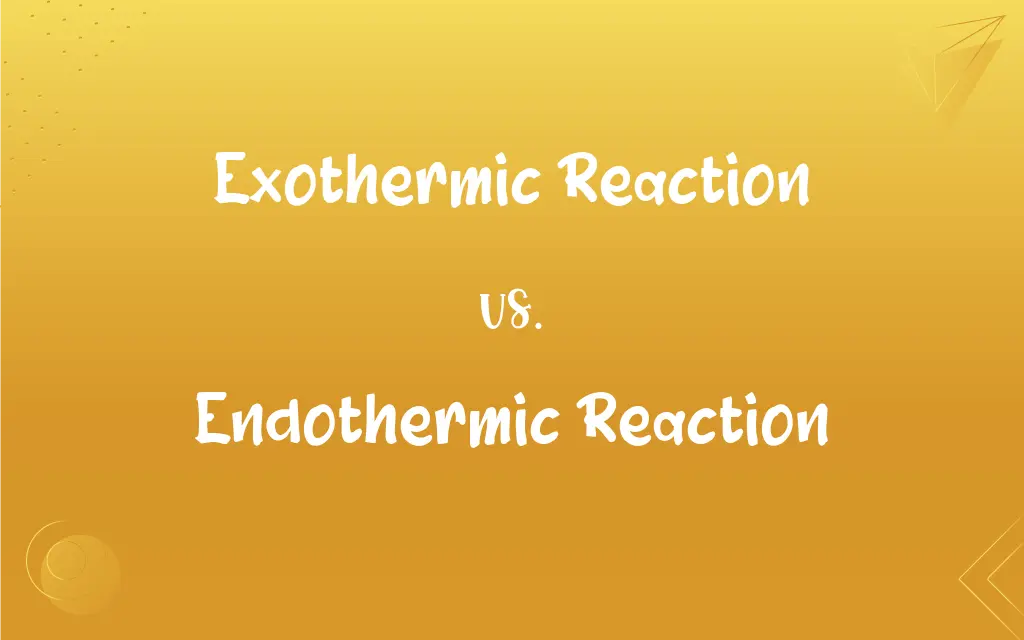Exothermic Reaction vs. Endothermic Reaction: What's the Difference?
Edited by Aimie Carlson || By Harlon Moss || Published on February 29, 2024
An exothermic reaction releases heat, while an endothermic reaction absorbs heat from its surroundings.

Key Differences
In an exothermic reaction, energy is released as heat, often making the surroundings warmer. Endothermic reactions absorb heat, causing the surroundings to become cooler.
Exothermic reactions result in a net release of energy, typically observed as heat and light. Endothermic reactions require energy input, absorbing heat to proceed.
Combustion is a common exothermic reaction, like a burning candle. Photosynthesis in plants is an endothermic process, absorbing sunlight.
Exothermic reactions often lead to more stable products and are generally spontaneous. Endothermic reactions result in less stable products and may require continuous energy input.
Exothermic reactions are utilized in heat production, like in heaters. Endothermic reactions are used in cooling processes, like in certain sports injury packs.
ADVERTISEMENT
Comparison Chart
Heat Transfer
Releases heat
Absorbs heat
Energy Flow
Energy is released
Energy is absorbed
Examples
Combustion, rusting
Photosynthesis, melting ice
Product Stability
Typically results in more stable products
Leads to less stable products
Typical Uses
Used in heating applications
Used in cooling applications
ADVERTISEMENT
Exothermic Reaction and Endothermic Reaction Definitions
Exothermic Reaction
Exothermic reactions result in a temperature increase of the surroundings.
The exothermic reaction in a hand warmer provides warmth in cold weather.
Endothermic Reaction
An endothermic reaction absorbs energy, typically as heat.
The endothermic reaction in photosynthesis absorbs sunlight.
Exothermic Reaction
In exothermic reactions, the products are typically more stable than reactants.
The formation of water from hydrogen and oxygen is a highly exothermic reaction.
Endothermic Reaction
These reactions require continuous energy input to proceed.
The melting of ice cubes is an endothermic reaction requiring heat.
Exothermic Reaction
An exothermic reaction releases energy in the form of heat.
The exothermic reaction of burning wood heats the room.
Endothermic Reaction
In endothermic reactions, products are less stable than reactants.
Baking soda and vinegar react endothermically to produce less stable products.
Exothermic Reaction
These reactions often emit light and heat, indicating energy release.
The bright flame of a candle is due to an exothermic reaction.
Endothermic Reaction
Endothermic reactions result in a temperature decrease in the surroundings.
An ice pack absorbs heat through an endothermic reaction to reduce swelling.
Exothermic Reaction
Exothermic reactions include combustion and oxidation processes.
Rust forming on iron is an exothermic reaction.
Endothermic Reaction
Endothermic processes include melting, evaporation, and photosynthesis.
The evaporation of water on the skin is an endothermic reaction that cools the body.
FAQs
What are common examples of exothermic reactions?
Burning fuels and rust formation are common exothermic reactions.
What characterizes an endothermic reaction?
An endothermic reaction absorbs energy, typically from its surroundings.
Can exothermic reactions occur spontaneously?
Many exothermic reactions are spontaneous due to the release of energy.
What defines an exothermic reaction?
An exothermic reaction releases energy, usually in the form of heat.
Is cooking an exothermic or endothermic process?
Cooking is often exothermic, especially when it involves combustion.
Do endothermic reactions require energy input?
Yes, endothermic reactions need continuous energy input to proceed.
What are typical endothermic reaction examples?
Photosynthesis and ice melting are examples of endothermic reactions.
Are endothermic reactions used in cooling technologies?
Yes, endothermic reactions are used in cooling packs and refrigeration.
Are endothermic reactions less common than exothermic?
Endothermic reactions are less common in everyday observations compared to exothermic.
Can endothermic reactions occur naturally?
Yes, many natural processes like evaporation are endothermic.
What role do exothermic reactions play in ecosystems?
Exothermic reactions like decomposition release energy into ecosystems.
How are endothermic reactions used in medical applications?
Endothermic reactions are used in cold packs to treat injuries.
How do exothermic reactions impact the environment?
Exothermic reactions can release heat and increase the surrounding temperature.
Are explosions exothermic reactions?
Yes, explosions are typically rapid and violent exothermic reactions.
Is sweating an example of an endothermic reaction?
Yes, the evaporation of sweat is an endothermic process.
What is a real-life application of an endothermic reaction?
Endothermic reactions are used in air conditioning systems to absorb heat.
How does temperature change in an endothermic reaction?
The temperature of the surroundings decreases in an endothermic reaction.
Why are exothermic reactions important in industry?
Exothermic reactions are crucial for energy production and manufacturing processes.
How does pressure affect exothermic reactions?
Pressure changes can impact the rate and extent of exothermic reactions.
Can an exothermic reaction be reversed?
Some exothermic reactions can be reversed, but it often requires energy input.
About Author
Written by
Harlon MossHarlon is a seasoned quality moderator and accomplished content writer for Difference Wiki. An alumnus of the prestigious University of California, he earned his degree in Computer Science. Leveraging his academic background, Harlon brings a meticulous and informed perspective to his work, ensuring content accuracy and excellence.
Edited by
Aimie CarlsonAimie Carlson, holding a master's degree in English literature, is a fervent English language enthusiast. She lends her writing talents to Difference Wiki, a prominent website that specializes in comparisons, offering readers insightful analyses that both captivate and inform.































































